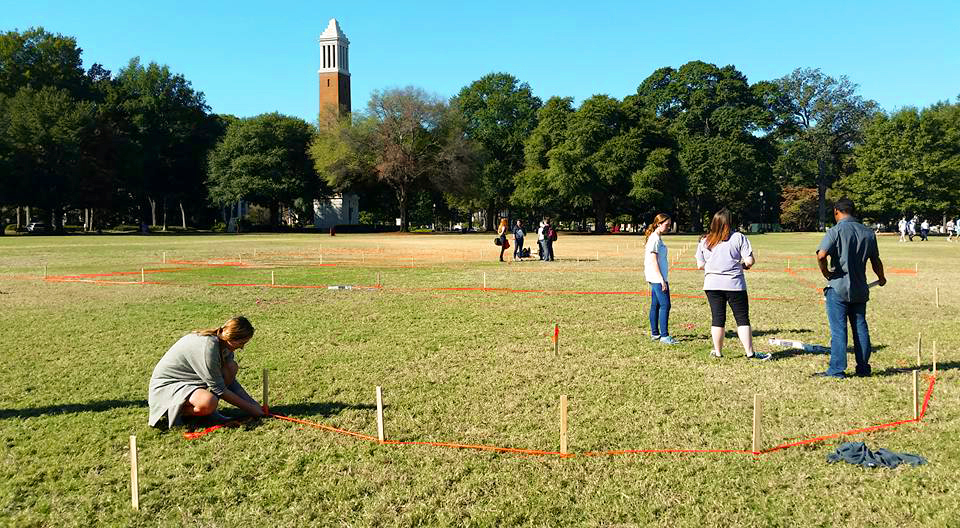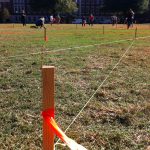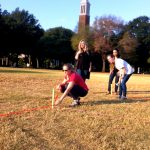
by Jennifer Feltman, Department of Art & Art History
Last week, students from my Late Medieval and Gothic Cathedrals courses worked together to lay out the plan of a cathedral on the Quad using only simple tools: wooden stakes, mallets, string, and a straight edge. After about 3 hours of work, they had the outlines of a plan about one-quarter the size of Amiens Cathedral. We were then able to walk around it and imagine the cathedral in three-dimensions.
Thanks to a Bluetooth speaker and my iPhone, placed in the area of the plan known as the choir, we listened to medieval chant and discussed the use of the various spaces in the cathedral. As we walked away from the choir, down the nave, the sound faded. I asked the class to imagine how this would sound in a real building with stone walls and vaults above. We then considered that Denny Chimes, measuring 115’ tall, would fit inside of the real cathedral of Amiens. With that, some realized for the first time how massive cathedral spaces are.
The goals of this activity are to
- demonstrate the interrelationship of geometry and architectural design
- show the relationship between the planned ideal and the actual building
- develop problem-solving skills through experiences
Geometry is fundamental to the design of cathedrals. One might even say that the buildings are visual expressions of geometric principles. This is a lesson more easily conveyed through demonstration and practice than lecture. As medieval masons learned their trade through apprenticeship, so, too, we better understand their work by actually doing some of it.
Before we attempted the layout on the quad, I taught students ancient principles of geometry through a directed in-class geometry exercise, where we completed a plan drawing of a cathedral using a compass and straight edge. We learned how to layout a plan ad quadratum (Latin for “from the square”), beginning with the central square of a cathedral plan called the “crossing.” From that point, the proportions of the Golden Section and the square root of two could be derived using a compass. When we did the activity outside on the Quad, the point of the compass became the stake in the ground and the arc drawn by the compass was generated by a length of string, which a person could hold taught while walking.
I divided the students into small “guild” groups and placed a grad or senior student in charge as lead mason of each group. This made the activity an exercise in teamwork. While I gave the students guidance, ultimately, I wanted them to work through any problems they encountered in laying out the plan. Part of the experience is problem-solving. This time the groups discovered that their chapels did not initially align. After re-measuring, they discovered that an error in one place led to errors in others — reinforcing the interdependence of the design.
As the final part of the project, I have students write reflections on the activity, which helps students to synthesize the material and provides useful feedback.


